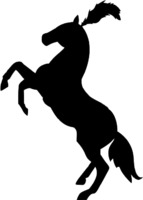Due to sensitive subject material within the archive, we encourage users to review our Harmful Content Statement before proceeding.
Come one, come all! Step right up, don't be shy....
----------------------------------------------------------------------------------------------------------
This archive is focused on the history of traveling circuses in the Ann Arbor area, and Michigan more broadly. We selected an assortment of images, newspaper articles, and route books documenting this history. We aim to highlight both the positive and negative aspects of circuses.
Circuses are a site of joy and fun for many people and we wanted to show examples of communities coming together to enjoy these events. However, there is a long history of the mistreatment of both the performers and the animals in these shows. People with marginalized identities such as physical disabilities or disfigurements (Huntley et al., 2015), people of color (Rodriguez, 2016), and people with non-normative genders (Dimuro, 2018) have all been represented in oppressive ways in circus performances.
This collection features many records documenting racist imagery and language, and further research on this topic will quickly lead users to discovering other examples of bigotry. Even if they aren’t featured in our collection, these other forms of bigotry still feel important to highlight.
These materials were mostly selected by visiting local University of Michigan archives to take our own pictures of them. We visited both the Bentley Historical Library and the William L. Clements Library to access materials in person, and we utilized connections with archivists at the Clements Library to access records that meet our criteria that were not listed in the finding aids. The route books were found via the Milner Library online archive at Illinois State University.
As stated above, the only real criteria for inclusion was that the records had to be documenting circuses in the state of Michigan. We included local circuses as well as traveling circuses from around the country and the world. Due to how many route books the team found online, those were limited more to the Ann Arbor area than the records of other formats.
The target audience for this archive includes people browsing the web for information on circuses for educational or entertainment purposes. This could range from amateur local historians, someone working on a book on this subject, or people simply looking for something interesting online for fun.
Because these users don’t necessarily have experience with archives, be that in person or online, we want to make this archive educational in that regard as well. The information about where the records were all sourced is readily available to encourage further research, and we were careful about how much information to make visible to users with regards to metadata.
The main archival concept that was considered when building this archive was the social implications of description. As Duff and Harris explain, no part of the descriptive process can truly be unbiased (Duff and Harris, 2002). This means that our team was very deliberate with how to engage with the potentially problematic aspects of the records. Brilmyer’s distinction between transcribing harmful language (which can still be done with intention, i.e. with a harmful language statement) and replicating that language in your own description (Brilmyer, 2018) was a helpful guide in this process.
Part of this process involved considering the perspectives that are captured in this archive and those that have been erased. The representations of marginalized groups that are featured in these records are primarily in the form of minstrelsy or another negative impersonation. Whenever marginalized people are actually representing themselves, they’re often forced to exaggerate their features and their life story for the show. In both cases, marginalized individuals aren’t able to represent themselves in a dignified manner of their own choosing.
Due to this being an archive documenting local history, it is very possible that someone could identify a family member in our records. This person may feel a particular way about the way that their loved one is described, and we will encourage users to reach out to the team if they would like to discuss this. Someone could also help to identify the locations of some of the records or other relevant pieces of information. Please contact the team at a2circuses@umich.edu.
Brilmyer, G. (2018). Archival assemblages: applying disability studies’ political/relational model to archival description. Archival Science, 18(95-118). https://doi.org/10.1007/s10502-018-9287-6
Dimuro, G. (2018, July 24). The Story of Annie Jones, P.T. Barnum’s Bearded Lady. All That’s Interesting. https://allthatsinteresting.com/annie-jones-bearded-lady
Duff, W. M., Harris, V. (2002). Stories and Names: Archival Description as Narrating Records and Constructing Meanings. Archival Science, 2, 263-285.
Huntley, C. et al. (2015). Clinical and historical aspects of the Elephant Man: exploring the facts and the myths. Gene, 555(1), 63-65.
Rodriguez, E. (2016, October 6). Not All Clowns Are Killers, But They Might Be Racist. Affinity Magazine. https://affinitymagazine.us/2016/10/06/not-all-clowns-are-killers-but-they-might-be-racist/
--------------------------------------------------------------------------------------------------------------------------------------------
Tagging images with useful search terms benefits the wider research community. If you have questions or concerns regarding any of the content in our archive, please contact us at: a2circuses@umich.edu


